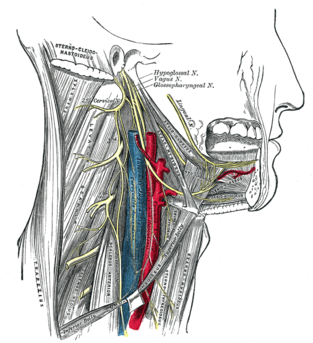Hypoglossal Nerve: Difference between revisions
No edit summary |
No edit summary |
||
| Line 6: | Line 6: | ||
== Examination == | == Examination == | ||
The tongue is first observed for position and appearance while it is at rest. Then the patient is asked to protrude the tongue, move it in and out, side to side, and up and down. The patient does each movement twice: once slowly and the next rapidly. The three observable aspects of the tongue are strength, bulk, and dexterity. Dexterity is tested by having the patient repeat sounds involving the tongue, such as saying "la la la" or use words with "t" or "d" sounds. Testing strength consists of the patient forcing the tongue to the side against the patient’s cheek, while the examiner tries to dislodge the tongue using his/her finger<ref name=":0">Kim SY, Naqvi IA. Neuroanatomy, [https://www.statpearls.com/articlelibrary/viewarticle/23265/ Cranial Nerve 12] (Hypoglossal). Available from: https://www.statpearls.com/articlelibrary/viewarticle/23265/<nowiki/>(accessed 7.2.2021)</ref>. | |||
Special attention is given when the tongue is weak, atrophied, moving abnormally, or impaired. | |||
{{#ev:youtube|e6X8vMYTSHs|300}}<ref>physiotutors.Cranial Nerve 12 | Hypoglossal Nerve Assessment for Physiotherapists. available from:https://www.youtube.com/watch?v=e6X8vMYTSHs</ref> | {{#ev:youtube|e6X8vMYTSHs|300}}<ref>physiotutors.Cranial Nerve 12 | Hypoglossal Nerve Assessment for Physiotherapists. available from:https://www.youtube.com/watch?v=e6X8vMYTSHs</ref> | ||
| Line 26: | Line 28: | ||
'''note in both cases there is wasting and fasciculation.''' | '''note in both cases there is wasting and fasciculation.''' | ||
The hypoglossal nerve is at high risk of injury during carotid endarterectomy.<ref name=":0" /> | |||
Obstructive Sleep Apnea and Hypoglossal Nerve Stimulation: In obstructive sleep apnea (OSA), the decrease in muscle tone of the genioglossus muscle causes the tongue to retract and impede airflow into the trachea. One possible treatment if the patient is refractory to continuous positive airway pressure (CPAP), oral devices, or surgery. Mild stimulation of the hypoglossal nerve causes the nerve to pull the tongue forward enabling better airflow<ref name=":0" /> | |||
Hypoglossal Nerve in [[Neurological Disorders|Neurologic]] Disorders: [[Progressive Supranuclear Palsy|Progressive bulbar palsy]] and advanced [[Motor Neurone Disease MND|MND]] can cause severe tongue atrophy and an inability for the tongue to be protruded leading to the inertia of the tongue. Fasciculations frequently occur with atrophy in the case of motor neuron disease. Tremors can also occur on the tongue in the case of [[alcoholism]], [[Parkinson's|parkinsonism]], and paresis. | |||
== References == | == References == | ||
1/Lin HC, Barkhaus PE. Cranial nerve XII: the hypoglossal nerve. Semin Neurol. 2009;29(1):45–52.<ref>1/Catala M, Kubis N. [https://www.sciencedirect.com/science/article/pii/B9780444529022000035 Gross anatomy and development of the peripheral nervous system.] Said G, Krarup C, editors. Handb Clin Neurol. 2013;115:29–41. 2/Lin HC, Barkhaus PE. Cranial nerve XII: the hypoglossal nerve. Semin Neurol. 2009;29(1):45–52.</ref> | 1/Lin HC, Barkhaus PE. Cranial nerve XII: the hypoglossal nerve. Semin Neurol. 2009;29(1):45–52.<ref>1/Catala M, Kubis N. [https://www.sciencedirect.com/science/article/pii/B9780444529022000035 Gross anatomy and development of the peripheral nervous system.] Said G, Krarup C, editors. Handb Clin Neurol. 2013;115:29–41. 2/Lin HC, Barkhaus PE. Cranial nerve XII: the hypoglossal nerve. Semin Neurol. 2009;29(1):45–52.</ref> | ||
Revision as of 07:52, 7 February 2021
Introduction[edit | edit source]
The hypoglossal nerve is the 12th cranial nerves that originate from the medulla obligate of the brain stem. It is mainly an efferent nerve for the tongue musculature.
Innervation[edit | edit source]
It gives only somatic motor innervation for all extrinsic and intrinsic muscles of the tongue except the palatoglossus, innervated by the vagus nerve.
Examination[edit | edit source]
The tongue is first observed for position and appearance while it is at rest. Then the patient is asked to protrude the tongue, move it in and out, side to side, and up and down. The patient does each movement twice: once slowly and the next rapidly. The three observable aspects of the tongue are strength, bulk, and dexterity. Dexterity is tested by having the patient repeat sounds involving the tongue, such as saying "la la la" or use words with "t" or "d" sounds. Testing strength consists of the patient forcing the tongue to the side against the patient’s cheek, while the examiner tries to dislodge the tongue using his/her finger[1].
Special attention is given when the tongue is weak, atrophied, moving abnormally, or impaired.
Lesion[edit | edit source]
UMNL:
1/ unilateral: deviation of the tongue to the opposite side of the lesion.
2/ bilateral: inability to protrude the tongue.
note in both cases there is no wasting or fasciculation.
LMNL:
1/unilateral: deviation of the tongue to the side of the lesion.
2/bilateral: inability to protrude the tongue.
note in both cases there is wasting and fasciculation.
The hypoglossal nerve is at high risk of injury during carotid endarterectomy.[1]
Obstructive Sleep Apnea and Hypoglossal Nerve Stimulation: In obstructive sleep apnea (OSA), the decrease in muscle tone of the genioglossus muscle causes the tongue to retract and impede airflow into the trachea. One possible treatment if the patient is refractory to continuous positive airway pressure (CPAP), oral devices, or surgery. Mild stimulation of the hypoglossal nerve causes the nerve to pull the tongue forward enabling better airflow[1]
Hypoglossal Nerve in Neurologic Disorders: Progressive bulbar palsy and advanced MND can cause severe tongue atrophy and an inability for the tongue to be protruded leading to the inertia of the tongue. Fasciculations frequently occur with atrophy in the case of motor neuron disease. Tremors can also occur on the tongue in the case of alcoholism, parkinsonism, and paresis.
References[edit | edit source]
1/Lin HC, Barkhaus PE. Cranial nerve XII: the hypoglossal nerve. Semin Neurol. 2009;29(1):45–52.[3]
- ↑ 1.0 1.1 1.2 Kim SY, Naqvi IA. Neuroanatomy, Cranial Nerve 12 (Hypoglossal). Available from: https://www.statpearls.com/articlelibrary/viewarticle/23265/(accessed 7.2.2021)
- ↑ physiotutors.Cranial Nerve 12 | Hypoglossal Nerve Assessment for Physiotherapists. available from:https://www.youtube.com/watch?v=e6X8vMYTSHs
- ↑ 1/Catala M, Kubis N. Gross anatomy and development of the peripheral nervous system. Said G, Krarup C, editors. Handb Clin Neurol. 2013;115:29–41. 2/Lin HC, Barkhaus PE. Cranial nerve XII: the hypoglossal nerve. Semin Neurol. 2009;29(1):45–52.







